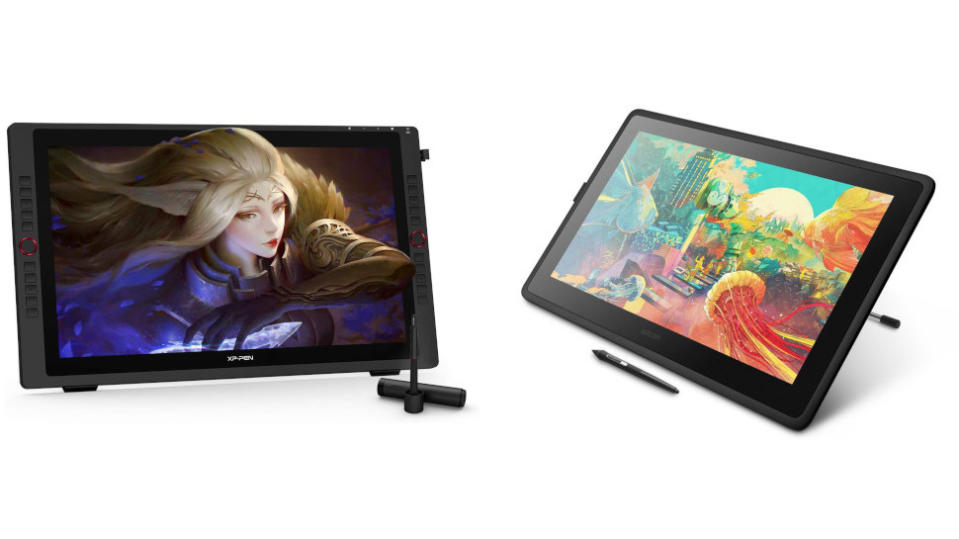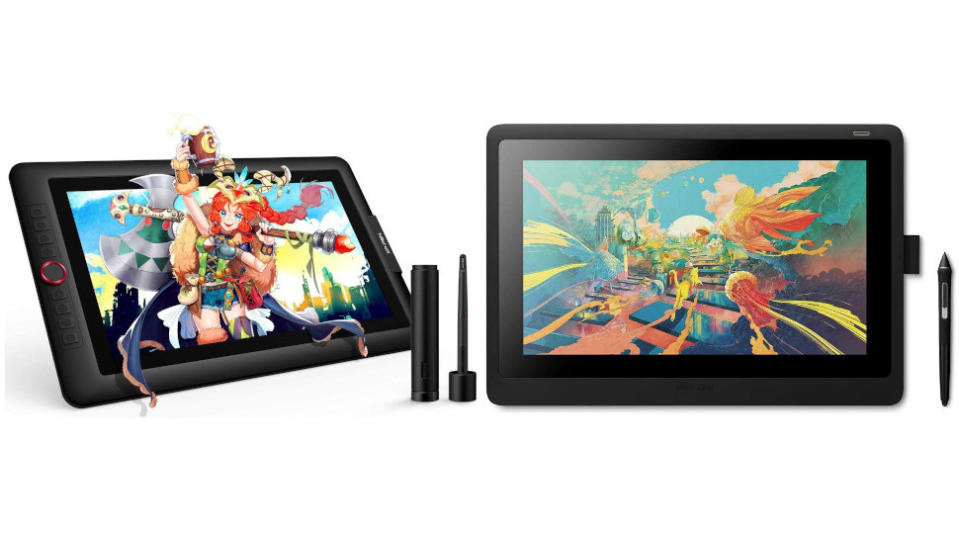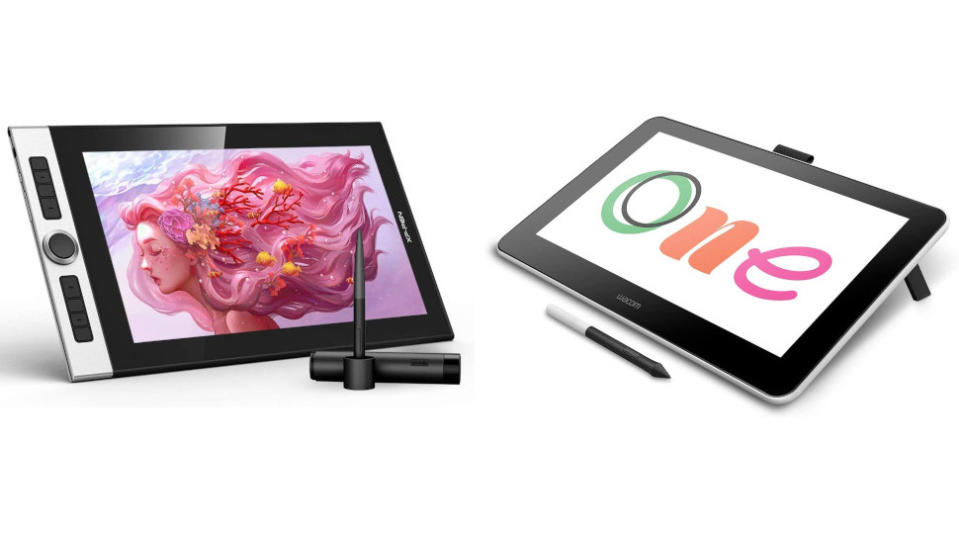Wacom vs XP-Pen: Which is for you?

Wacom vs XP-Pen - what's the best drawing tablet for your needs? The days when Wacom was the only real name in digital design are long gone, and while the brand remains the market leader, smaller manufacturers, such as XP-Pen, have made a name for themselves by undercutting Wacom on price.
The formula of the past was that Wacom = superior but expensive, and XP-Pen = cheaper but less good. If this were still true, it would make the question of which to choose pretty easy! But things have moved on from then, and XP-Pen is a real contender to consider if you want quality at a great price.
Speaking of getting a great price, take a look at our Black Friday drawing tablet deals page where we've been rounding up the very best early deals and discounts on an array of drawing tablets and pen displays - the highlight being $1,000 off the latest Wacom MobileStudio Pro 16.
Both brands have continued to release new models that complicate the picture. Take, for instance, the recent XP-Pen Artist 24 Pro, which is very clearly gunning for the professional market with its 23.8-inch QHD display. Meanwhile, XP-Pen continues to shore up its excellent credentials in the mid-range of graphics tablets, with recent releases like the XP-Pen Innovator 16. Tablets like this provide a great happy medium, offering a drawing area that’s big enough for most purposes, and enough features and functionality to keep the majority of digital artists happy, all for a very competitive price.
Wacom hasn’t rested on its laurels, however. The fact remains that if you’re a professional artist who needs the best tablet money can buy, it’s going to be a Wacom. What’s more, the firm has recently engaged in a drive to make its flagship more affordable, and digital art more accessible to everyone. Tablets like the Wacom One are competitive in the budget market, while the Wacom Cintiq 22 is a class-leading budget professional tablet.
So, when deciding whether you want a Wacom or an XP-Pen tablet, it’s worth breaking down their features and looking in closer detail. That's exactly what this article does for you. We’re going to be looking at three major model comparisons, giving you the best chance to get the drawing tablet that best suits your needs.
Also, we've got you covered if you want a great deal on the best drawing tablets on sale right now, or if you want to explore some more of the best Wacom alternatives out there.
Wacom vs XP-Pen: Design

In terms of basic design, there’s not a huge amount to cover – drawing tablets are pretty simple things, physically speaking, and you’ll find many consistent differences between Wacom and XP-Pen even as you look at different models.
Let’s take, for instance, the Wacom Cintiq 16 and the XP-Pen Artist 15.6 Pro. The Wacom tablet has superior build quality, with a stronger-feeling design that feels heavy and sturdier. It weighs about 1.9kg; the XP-Pen Artist 15.6 Pro weighs 1.5kg. That’s not a huge difference unless you’re carrying the tablet around all day, in which case, believe us, you’ll notice it.
Visually, there are some immediate differences that you’ll notice. From the front on, the Wacom Cintiq 16 is all screen, while the XP-Pen Artist 15.6 Pro has visible buttons on one side. These are the shortcut keys, of which there are a total of eight, along with the distinctive red dial that can be used for zooming and other controls.
The Cintiq 16, meanwhile, is best controlled by plugging in a laptop using the 3-in-1 cable and making use of the Wacom Desktop Center. There isn’t even Touch functionality on the Cintiq 16 – part of keeping the cost down.
The Wacom experience definitely feels more premium, not least because of the better build quality of the tablet. But don’t count out XP-Pen, whose button-led setup has more scope for being customised to user preference.
Wacom vs XP-Pen: Display

At the high end, Wacom rules the roost when it comes to displays. If you’re willing to drop a four-figure sum on something like the Wacom Cintiq Pro 32, you get a dazzling 32-inch 4K display capable of outputting 1.07 billion colours.
But if that’s your vibe, you don’t need a guide like this. Let’s take a look at two similarly priced models – the Wacom Cintiq 22 and the XP-Pen Artist 24 Pro. The Cintiq 22 has a 22-inch Full HD display covering 96% of the sRGB colour gamut (72% NTSC). The XP-Pen Artist 24 Pro, meanwhile, edges it in both size and resolution, with a 23.8-inch QHD (2560 x 1440) screen that covers 90% of Adobe RGB.
Both tablets have high-quality displays that are satisfying and intuitive to draw on. If you’re weighing up in sheer quality terms, you’re best off with a Wacom, but in terms of value for money, the XP-Pen gives more bang for buck.
Wacom vs XP-Pen: Features
Both Wacom and XP-Pen tablets naturally come with their own bespoke stylus. Both are pretty much what you’d expect – XP-Pen styluses tend to be a little lighter than Wacom ones. As is the theme you may have noticed by now, compare a Wacom and XP-Pen at the same price and the XP-Pen will have more features, with less of a premium feel.
So, for instance, the XP-Pen Innovator 16 comes with a lightweight stylus boasting 8,192 pressure sensitivity levels. Meanwhile the Wacom One, available for about the same price, comes with a more basic stylus than the top-end Wacom tablets, with 4,096 pressure levels. The XP-Pen stylus also has two programmable buttons, compared to one on the Wacom.
Wacom vs XP-Pen: Performance
Drawing on a Wacom has been a superb experience for quite some time, and the firm has only refined this as time has gone on. The anti-glare glass surface of a tablet like the Cintiq 22 provides a pleasing “bite” against the stylus. Wacom styluses have a pleasing heft to them, and if you get a tablet that comes with the Pro Pen 2, you’ve pretty much got the best stylus in the business.
XP-Pen drawing is generally good, but doesn’t quite have that effortless premium perfection that Wacom does. Compare drawing on a tablet like the XP-Pen Artist 15.6 Pro to drawing on a Wacom, you’ll probably notice the tilt function is less sensitive. Users have reported occasional line jitter and line lag as well. XP-Pen software tends to be less reliable, more prone to crashing and taking longer to install. There’s no getting around the fact that it is, all in all, a much less smooth experience.
Wacom vs XP-Pen: Price

We’ve discussed this quite a bit already, as it really is the main difference between XP-Pen and Wacom. If you have, for example, $800-ish to spend on a drawing tablet, you can choose between two fantastic tablets. The XP-Pen will be more bang for your buck, with in this instance a larger screen that’s higher resolution – the XP-Pen Artist 24 Pro with its QHD 24-inch screen versus the Wacom Cintiq 22 and its 22-inch Full HD screen. The Wacom, however, will feel more premium, provide a smoother and more reliable drawing experience.
Wacom vs XP-Pen: Our verdict
If money is no object and you need the best drawing tablet, get a Wacom. Easy. Once you get into premium, high-end, professional tablets, Wacom models like the Wacom Cintiq Pro 32 are the best in class.
If you’re working with a more restricted budget, however, then it’s worth considering your options. XP-Pen tablets provide more bang for your buck, and are a great choice if you like a great deal of flexibility with how to set up your tablet, with customised hot-keys. By contrast, if your priority is simply something that feels good to draw on, offering a premium user experience, then Wacom is still the way to go. And, thanks to the work Wacom has done recently in filling out its budget offering, you won’t necessarily have to break the bank.
Wacom vs XP-Pen: Deals
Related articles:
Best Wacom alternatives: From Huion to XP-Pen

